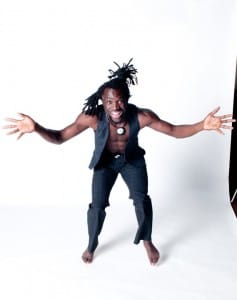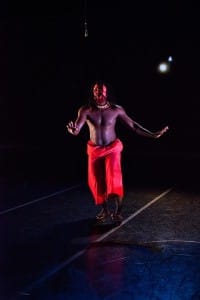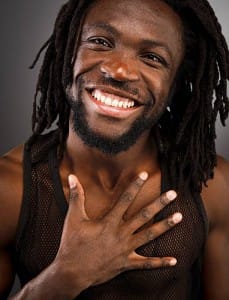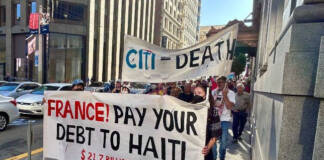by The People’s Minister of Information JR
On Saturday and Sunday, Dec. 12 and 13, Mbongui Square Festival will be celebrating art and community through dance. Over two dozen dancers and choreographers from places as diverse as the Congo, the Ivory Coast, France and the United States will be showing off their moves.
The Mbongui Square Festival will take place at Zaccho Studio, which is located at 1777 Yosemite Ave., in San Francisco’s Bayview Hunters Point.
We caught up with choreographer Byb Bibene of the Kiandanda Dance Theater Company to fill us in on what will be going on at the Mbongui Square Festival, as well as his history with dance and more.
M.O.I. JR: Where are you from? What made you fall in love with dance?
Byb Bibene: I was born and raised in the Republic of Congo, a country in central Africa. Dance has always been part of my culture, my life.
Dance life is very present in the Congo. Dance and music are two things I can’t dissociate. On every corner of the streets, there is a dancing bar – there is space where groups are rehearsing, traditional dances, pop dances.
It is very present, so in a natural way I was a potential dancer – though I became interested in dancing professionally after I had attended a contemporary dance group that mixed African dance forms well with Western contemporary dance aesthetic and hip-hop energy.
That was new, innovative – that was something I wanted to try. I tried it and fell in love right away and I never left.
M.O.I. JR: What made you want to become and how did you become a choreographer?
Byb Bibene: I became a choreographer by necessity. After dancing for years in different dance groups, there came a time I wanted to make a dance piece that sounded like my vision, that represented me. I’m a dreamer. I started making small solo works, and then duets and finally I got to put together a group work.
At first I did not have the skills, but I asked for assistance from more experienced choreographers who offered their guidance. After experiencing and creating many pieces, I guess I then understood how to craft an idea, translate it into dance, designed for the stage.
M.O.I. JR: What is the meaning of the word Mbongui?
Byb Bibene: Mbongui is a word that originated from the Congo that refers to togetherness. It’s in the Kongo language.

It refers to a place where family, neighbors, passers-by and foreigners come together to share meals, stories and knowledge and/or receive assistance from the community. It is a welcoming place, a transformative place, an inspiring place in which each person’s story may represent a new direction, another way to keep breaking boundaries and connect people.
Back in the day in Congo, the Mbongui was this big house located in the center of a village. This is the place where all the villagers went to, day or night, to listen to the elders, to learn about stories about the ancestors and different cultural knowledge.
M.O.I. JR: How did the Mbongui Square event start? Why? When?
Byb Bibene: The idea to create Mbongui really started after I moved to the USA in 2009 and observed that race is very hot topic in this country. There is one thing that is very rich about the Bay Area is diversity; there are different communities representing people from the Caucasian culture, the Hispanic culture, the Asian and Indian culture, the African and African American culture.
This is rich. But unfortunately the people from these communities don’t always meet on common ground. There are tensions that keep them divided in a way. The tensions between Caucasians and African Americans is particularly intense. No need to recall the historical facts.
So, I started dreaming, dreaming to create an event that not only would allow multicultural and multidisciplinary art works, but a place that would connect artists and audience members from different racial backgrounds, reinforcing a notion that everybody can live together and develop this country at its best.
So Mbongui Square, launched in 2012, exists to keep connecting and inspiring people by the way of the art of dance, music, spoken word, visual art. What is particular about this event is people not only can enjoy professional arts but also share food and drink. We provide that for everybody, because there is no Mbongui with no food and drinks and fun.
I started dreaming, dreaming to create an event that not only would allow multicultural and multidisciplinary art works, but a place that would connect artists and audience members from different racial backgrounds, reinforcing a notion that everybody can live together and develop this country at its best.
M.O.I. JR: Can you tell us about this year’s Mbongui Square event?
Byb Bibene: This year Mbongui Square has pretty much the same format. We have stayed faithful to programing diversity in the art genres to be presented, because we believe the Mbongui is a village of multidisciplinary arts.
Mbongui Square will take place at Zaccho Studio. I thank them for welcoming us back.
M.O.I. JR: Who are some of this year’s performers and where are they from?
Byb Bibene: There are about 25 artists on the program, 22 local performers and three from abroad. We have international guest artists this year.
There is one choreographer from Germany-Ivory Coast, Ange Aoussou; one choreographer from France, Florent Mahoukou; and one choreographer from the Republic of Congo, Chris Babingui. They will each present solo works.
This is a first to artists coming from far away. We wish we had funding to bring more foreigners to the Bay to share their work. Some of the local artists are Shereel Washington – she does Hula; Dana Lawton, modern dance; Nava Dance Theater, Indian dance; Kinetech Arts, visual arts; Christina Brown, Butoh; Joy Elan, spoken word.

M.O.I. JR: What role does dance play in societies around the world? Why is it important?
Byb Bibene: I can’t imagine life without dance. We all are dancers by nature or like to dance. Movement is the first human language.
Dance is a therapy, and this applies to all societies around the world. Dance makes us feel good in our body. We celebrate a wedding, for instance, with dancing. There is just no life without dance.
M.O.I. JR: What role has the art of dance played in African societies historically?
Byb Bibene: Dance has always been a very important part of Congolese society. I would avoid speaking of all the African societies, since Africa is a huge continent and each country has its particular dance culture.
Since I have not visited all the African societies, I would not put Africa in a box – though there are a few similarities in the Central African countries of the role that dance plays in society, especially where Bantu people live.
Historically, dance was always associated with a social event. There was a dance for hunting, dance for fishing, for wedding celebrations, for birth, for death, for harvest, for health and wealth, dance of passage from teenage to adulthood; I can’t name all of them.
Our ancestors believed it was necessary to dance for an event in order to guarantee its success or celebrate it. Dance was sometimes associated with acting.
There were, I remember, musical groups in the Congo. I was young. These groups combined dance, singing, music and spoken word to narrate a story, to educate the youth, to empower moral values in the society.
M.O.I. JR: How could people keep in touch with you?
Byb Bibene: We have an email and mailing lists; we encourage people to join the list via our website www.kiandanda-dance.com. People can subscribe on the front page of the website. We also have a Facebook page, which can be found here: https://www.facebook.com/MbonguiSquare?ref=hl.
People can also send an email to maza.co@live.com for any inquiry. Tickets for Mbongui Square are on sale at Eventbrite: www.mbonguisquare2015.eventbrite.com.
Also, my company is fiscally sponsored by Dancers Group, a 501(c)(3) organization. So we accept tax deductible donations. This link should take you directly to the support page: http://kiandanda-dance.com/support-us.
The People’s Minister of Information JR Valrey is associate editor of the Bay View, author of “Block Reportin’” and “Unfinished Business: Block Reportin’ 2” and filmmaker of “Operation Small Axe” and “Block Reportin’ 101,” available, along with many more interviews, at www.blockreportradio.com. He can be reached at blockreportradio@gmail.com.






